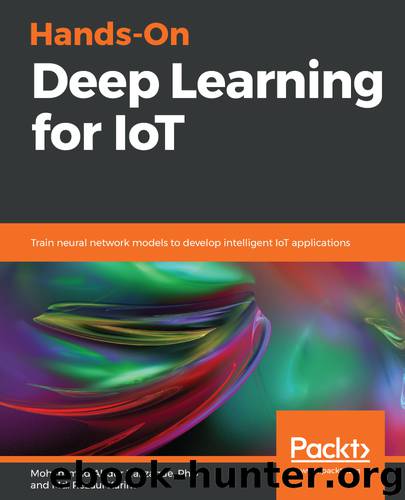Hands-On Deep Learning for IoT by Mohammad Abdur Razzaque PhD

Author:Mohammad Abdur Razzaque, PhD
Language: eng
Format: epub
Tags: COM044000 - COMPUTERS / Neural Networks, COM016000 - COMPUTERS / Computer Vision and Pattern Recognition, COM004000 - COMPUTERS / Intelligence (AI) and Semantics
Publisher: Packt Publishing
Published: 2019-06-27T06:26:31+00:00
Exploratory analysis
The exploratory analysis of data using the Python pandas library provides many powerful features–no doubt. However, using df.describe(), df.dtypes, or using df.isnull().sum() and plotting them separately is always time-consuming. Sometimes, you won't even get the required information in a sophisticated way. In fact, you'll have to write extra lines of code to convert them into a presentable format. However, to make your life easier, you can now start using the pandas_profiling library (see https://github.com/pandas-profiling/pandas-profiling). Just one line of code will give the information you need:
pandas_profiling.ProfileReport(df)
Surely, it would be worth using pandas_profiling to get a quick understanding of your data. Let's try it out! First, we read the training data by explicitly passing header=0 to be able to replace the existing names:
trainDF = pd.read_csv("trainingData.csv",header = 0)
To retrieve the list of variables that are rejected due to high correlation, you can use the following command:
profile = pandas_profiling.ProfileReport(trainDF)
This will produce a report showing information on the dataset:
Download
This site does not store any files on its server. We only index and link to content provided by other sites. Please contact the content providers to delete copyright contents if any and email us, we'll remove relevant links or contents immediately.
| Computer Vision & Pattern Recognition | Expert Systems |
| Intelligence & Semantics | Machine Theory |
| Natural Language Processing | Neural Networks |
Algorithms of the Intelligent Web by Haralambos Marmanis;Dmitry Babenko(16234)
Jquery UI in Action : Master the concepts Of Jquery UI: A Step By Step Approach by ANMOL GOYAL(9386)
Test-Driven Development with Java by Alan Mellor(7735)
Data Augmentation with Python by Duc Haba(7608)
Principles of Data Fabric by Sonia Mezzetta(7378)
Learn Blender Simulations the Right Way by Stephen Pearson(7294)
Microservices with Spring Boot 3 and Spring Cloud by Magnus Larsson(7137)
Hadoop in Practice by Alex Holmes(6587)
RPA Solution Architect's Handbook by Sachin Sahgal(6515)
The Infinite Retina by Robert Scoble Irena Cronin(6216)
Big Data Analysis with Python by Ivan Marin(5933)
Life 3.0: Being Human in the Age of Artificial Intelligence by Tegmark Max(5514)
Pretrain Vision and Large Language Models in Python by Emily Webber(4894)
Infrastructure as Code for Beginners by Russ McKendrick(4653)
Functional Programming in JavaScript by Mantyla Dan(4436)
WordPress Plugin Development Cookbook by Yannick Lefebvre(4382)
The Age of Surveillance Capitalism by Shoshana Zuboff(4245)
Embracing Microservices Design by Ovais Mehboob Ahmed Khan Nabil Siddiqui and Timothy Oleson(4148)
Applied Machine Learning for Healthcare and Life Sciences Using AWS by Ujjwal Ratan(4135)
